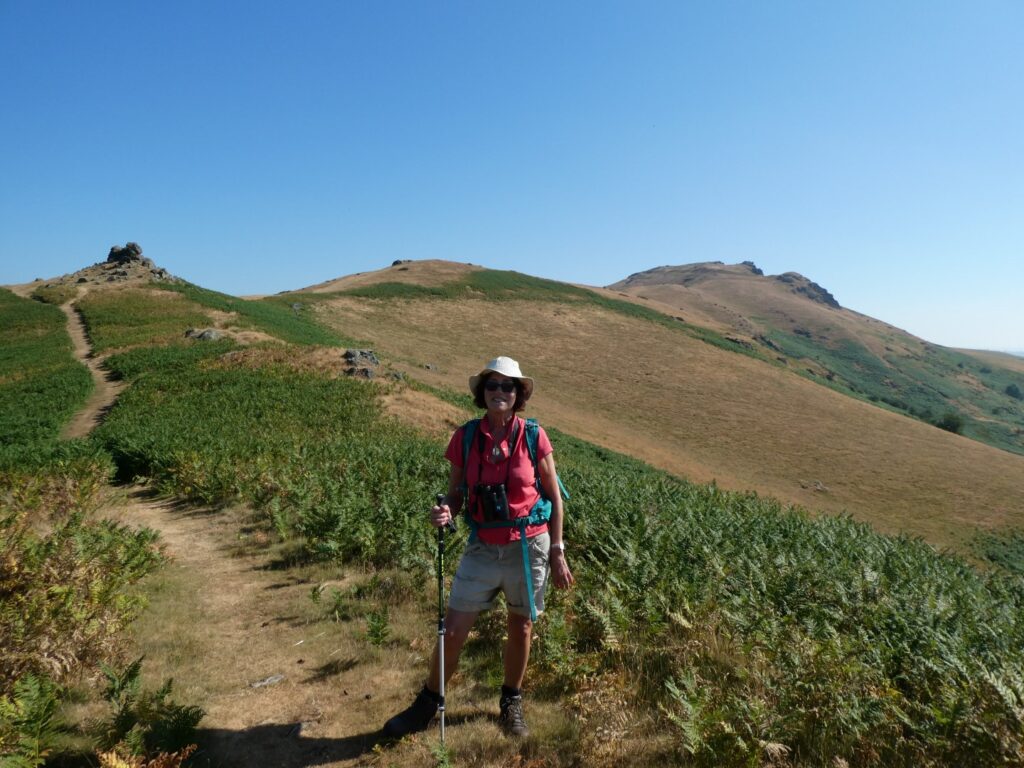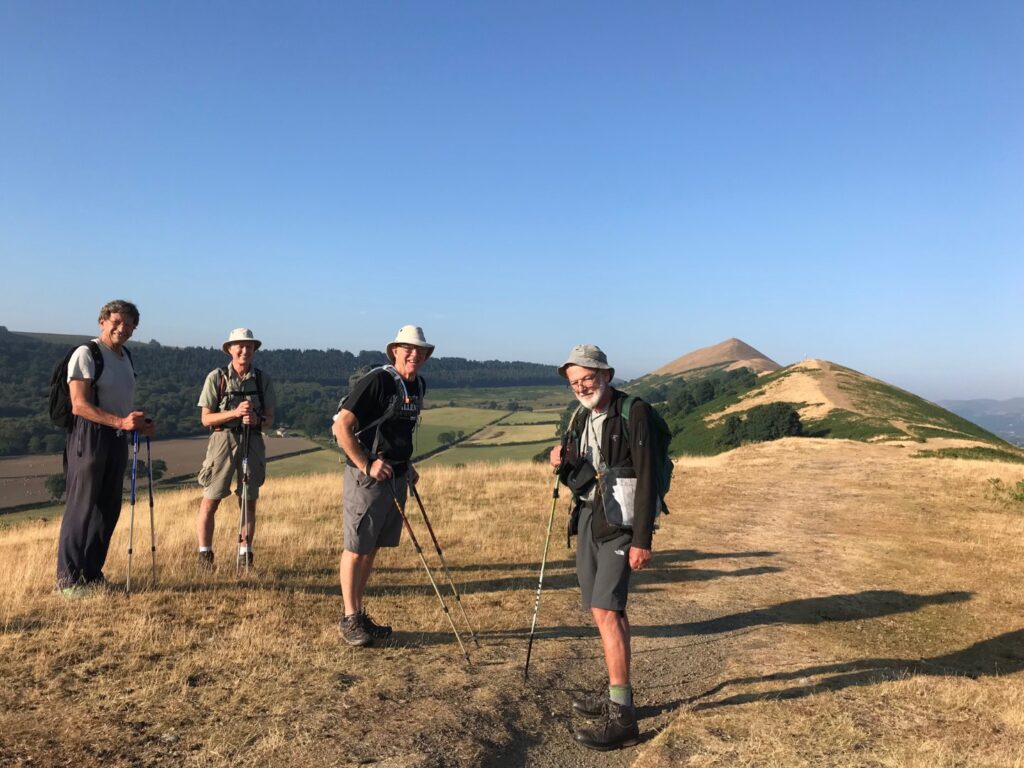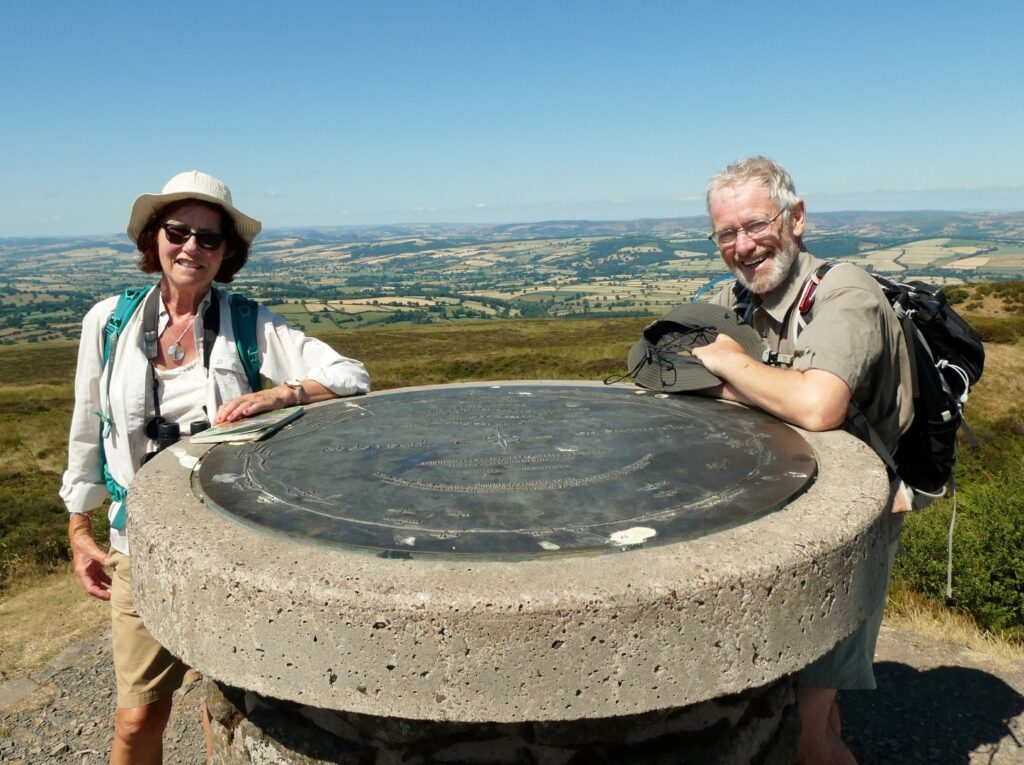Meet Report: 6-8 July 2018.

This year’s long walk presented a set of unusual challenges. It was based in a part of the country unfamiliar to many: the hills of Shropshire. Though these are modest by Yorkshire standards, the 58 km suggested route still involved significant ups and downs (1,900 metres of ascent in total). The weather was unusually hot and dry, with the clear blue skies and soaring temperatures of previous weeks continuing over the weekend, so the going was dry and firm underfoot, but sunburn and dehydration were real risks. In addition the original meet leader had taken a slightly unexpected opportunity to backpack in Spain, and was unsure of his return date, so the meet ended up with a slightly bemused Rory as cat-herder in chief. Furthermore, the meet was overbooked, but 2 late dropouts reduced us to the 16 for whom the bunkhouse accommodation was designed.
All those attending arrived safely on Friday late afternoon or evening, some direct and some via a local walk on the Stiperstones, with red kites and buzzards sighted; some had brought food, some went out together to a local pub in Much Wenlock, and a few sampled several hostelries with a view to selecting the best.
In spite of this, most of the party were up early, having laid plans the previous evening.
Richard S set off at 04:30 from the bunkhouse, planning to complete the whole circuit, which he did. This was a loop starting at The Granary bunkhouse just outside Much Wenlock, working across country to the Lawley, following the ridge line over this and Caer Caradoc, descending to All Stretton, ascending to Pole Bank, the highest point on the Long Mynd, descending to Church Stretton, working across country to Wenlock Edge and following this home.
Michael and Felicity, Mick, Nick and John Sutcliffe were driven to the foot of The Lawley by Rory and Richard D, cutting out the first (least interesting?) section, losing about 13 km but only 170 metres of ascent; they arrived at about 07:00, just neatly in time to meet Richard Smith.

The Smith party continued southwest along the pleasant ridge of The Lawley (above the line of Roman Watling Street, and with good views of Penkridge Hall, an old Manor), and on over Caer Caradoc with its iron-age hill fort, and an awkward steep descent towards All Stretton. The rest of the Lawley party followed a few minutes behind, admiring good views, birds and butterflies. Rory cut back from the top of Caer Caradoc to collect his car. Richard Dover cut across from the Strettons to Wenlock Edge, and followed this northwest back to the bunkhouse.
The rest of the attendees sensibly looked at shorter options. Carol and John Whalley walked up the Long Mynd from Church Stretton. Jim and Christine walked Caer Caradoc, explored Cardington village (with pub) and cut back to the car via the Gaer Stone; comma butterflies were highlights, but they found it all rather hot (they were not alone in this).
Paul and John Lloyd had a walk on the Long Mynd, up to Pole Bank from All Stretton; John had a fall on descent, twisting his knee; Alan and Derek rescued him, and the four continued to research local hostelries.
Meanwhile the Smith party were pushing on in spite of punishing heat, following Cross Dyke up to the summit of the Long Mynd; this proved to be the busiest section of the walk, with lots of other walkers, cyclists, sightseers, horse-riders, hill ponies and a collection of radio hams setting up aerials near Pole Bank; (a YRC ham noted how much smaller radio equipment had become). The party descended via the Boiling Well and Devil’s Mouth and paused in Church Stretton for lunch, ice-cream and to restock on water, then pushed gamely (and rather tediously) on via farmland and minor roads to Eaton; an ascent of Jacob’s Ladder led them onto Wenlock Edge, which was followed back to the bunkhouse. The route along the Edge followed bits of the Shropshire Way and the Jack Mytton Way, mostly through mature woodland, which gave welcome shade but obscured the views. They discussed “Mad Jack” Mytton (more of him later; it is not entirely clear why he has a Way named after him, but his career is remarkable though not exemplary), and finally arrived back, hot and rather weary, at 18:30.
Mick, Nick and John Sutcliffe followed the same route, but rather more slowly. After meeting Rory in Church Stretton for a welcome drink (and some discussion about why the town is there (carding mills, we think), they tramped on to Wenlock Edge, and after some negotiation (they were informed by a helpful horsewoman that their original pub objective was closed!) were collected from Wilderhope Manor, an interesting old building gifted to the YHA, a possible venue for a future meet, and most importantly in context, with a bar that sold beer. This was about 12 km from the bunkhouse, and they were the last party home at 20:00.
In view of the heat, supper was quiche, salad and cold new potatoes, and fruit salad with ice cream; this was enjoyed by all.
On Sunday (still very hot and sunny) many people just made for home, but Jim, Christine and Michael collected the highest point in Shropshire, Abdon Burf on Brown Clee, with panoramic views including the Malverns, the Brecons, Cader Idris, the Arans, the Berwyns, the Wrekin and the southern Peak District, and more butterflies (Jim the lepidopterist claimed that the weekend had been punctuated by commas). Meanwhile Mick and Rory walked the various tops of Hope Bowdler hill, with good views and (much to the delight of Mick the other lepidopterist on the meet) a group of green-veined white butterflies drinking at a patch of bog.

Thanks to all those attending for making this a success, in particular John S for the original idea, Mick for advice and route planning, Michael for Jack Mytton research, and all the kitchen team.
Attending:
Michael and Richard Smith; Felicity Roberts (G); Paul and Richard Dover; Mick Borroff; Carol and John Whalley; Christine and Jim Harrison; Alan Clare; Derek Clayton; John Lloyd; John Sutcliffe; Nick Welch and Rory Newman (meet leader and report writer).
3 Shropshire Characters.
Wild Edric was a British landowner active at the time of the Norman Conquest. He had property in Shropshire. He was active in a revolt against William the conqueror, but later made his peace with him and campaigned with him against the Scots. Later in life he married a fairy woman (so the story goes); he lives on in the fairy hills, including Caer Caradoc; he was known for helping the Shropshire lead miners (who of course worked on/in the hills); he now leads the Wild Hunt, riding out particularly before Britain goes to war.
Much of the 2018 Long Walk followed the Jack Mytton Way. Mad Jack Mytton was a Regency rake and famous eccentric, from a Shropshire landowning family. He was expelled from Winchester and Harrow (where he only lasted 3 days) schools, the former for fighting with a master. Not surprisingly he was reported as having “no academic ability” but still went to Cambridge University; he arrived with luggage which included 2000 bottles of port, so again it’s not a surprise that he left without a degree. He became an MP in 1819 (his election campaign was a great success as he offered £10 notes to potential voters) but only attended the Commons once, finding the speeches too dull to bear so never went back. His reputation for eccentricity was well-merited: angered by finding a toll gate closed, he spurred his horse to leap over it, disregarding the fact that it was pulling a carriage (which was of course wrecked); he hunted duck by crawling over a nocturnal frozen lake dressed only in a nightshirt; he tried to cure his hiccups by setting fire to the same nightshirt (the fright cure); he entertained guests by inviting them for dinner then dressing as a highwayman and ambushing them en route. He once rode a bear into a local meeting….this was surprisingly uneventful until he used his spurs on the animal, which then bit his leg and attacked his servant. After all this he died at 38 in a debtors prison, ruined by drink and with gangrene of the leg.
By contrast there is a gravestone in Bishop’s Castle churchyard commemorating Matthew Marston, a local burgess; Bishop’s Castle was a famous rotten borough, and the local burgesses sold their votes to the highest bidder (by 1802, when Marston died, the going rate was £25). But Marston was remarkable in voting according to his conscience and refusing to accept bribes, so remarkable in fact that this was recorded on his tombstone. Honest politicians were hard to find in 1802; have times changed? I wonder….
Leave a Reply